大学英语说课比赛优秀模板共30页文档
英语说课模板(全英文版)——获奖说课稿
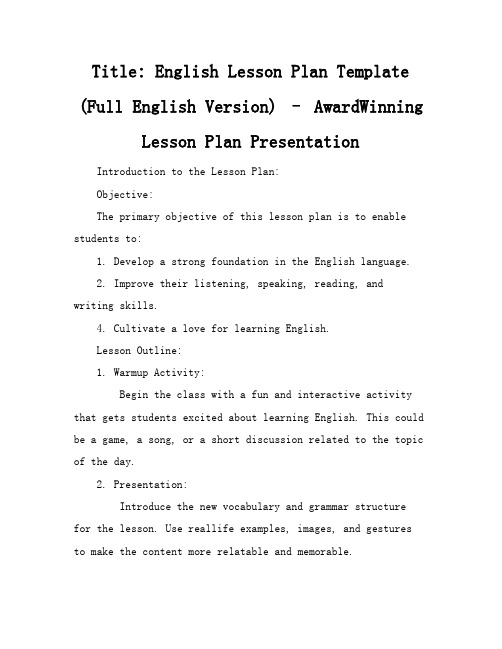
Title: English Lesson Plan Template (Full English Version) – AwardWinning Lesson Plan PresentationIntroduction to the Lesson Plan:Objective:The primary objective of this lesson plan is to enable students to:1. Develop a strong foundation in the English language.2. Improve their listening, speaking, reading, andwriting skills.4. Cultivate a love for learning English.Lesson Outline:1. Warmup Activity:Begin the class with a fun and interactive activity that gets students excited about learning English. This could be a game, a song, or a short discussion related to the topic of the day.2. Presentation:Introduce the new vocabulary and grammar structurefor the lesson. Use reallife examples, images, and gesturesto make the content more relatable and memorable.Engage students in the presentation asking questions and encouraging participation.3. Practice:Divide students into pairs or small groups topractice using the new vocabulary and grammar structure. Provide them with various activities, such as roleplaying, dialogues, or worksheets.Monitor the students' progress and offer guidance as needed.4. Production:Encourage students to create their own sentences or short dialogues using the target language. This could be in the form of a written assignment, a presentation, or an impromptu speech.Provide constructive feedback to help students improve their language skills.5. Cooldown Activity:End the lesson with a relaxing and reflective activity, such as a short story, a poem, or a mindfulness exercise. This allows students to consolidate their learning and transition to the next class.Assessment:Throughout the lesson, use formative assessment techniques to gauge students' understanding and progress.This can include observations, quizzes, and selfassessments. At the end of the lesson, provide a summary of the key points and reinforce the importance of practice and continuous learning.Conclusion:This awardwinning English lesson plan template is designed to create a dynamic and effective learning environment. By following this structured approach, teachers can help students achieve their language learning goals and develop a lifelong passion for English.3. Differentiation:To cater to the diverse learning needs of students, the lesson plan includes various differentiation strategies: Visual Aids: Provide visual support for visual learners through diagrams, charts, and flashcards.Auditory Cues: Use music, audio recordings, and verbal explanations to assist auditory learners.Kinesthetic Activities: Incorporate movement and handson activities for kinesthetic learners, such as acting out vocabulary words or using manipulatives.Supported Practice: Offer additional resources and oneonone support for students who may need extra assistance.4. Classroom Management:Maintaining an organized and engaging classroom environment is crucial for the success of the lesson. Here are some tips for effective classroom management:Establish Clear Expectations: At the beginning of the lesson, set clear rules and expectations for behavior and participation.Use Engaging Techniques: Employ a variety of teaching methods to keep students motivated and attentive, such as thinkpairshare or small group discussions.Monitor Student Progress: Regularly check in with students to ensure they are on track and address any issues promptly.5. Technology Integration:Leverage technology to enhance the learning experience and make the lesson more interactive:Online Resources: Utilize educational websites, videos, and apps to supplement the lesson material.Interactive Whiteboard: Use an interactive whiteboard to display visuals, create interactive activities, andfacilitate group work.Digital Portfolios: Encourage students to create digital portfolios to track their progress and showcase their work.6. Reflection and Feedback:End each lesson with a reflection session to encourage metacognition and personal growth:Student Reflection: Ask students to reflect on what they learned, what they found challenging, and how they can improve.Peer Feedback: Encourage students to provide constructive feedback to their peers, promoting a culture of collaboration and support.Teacher Feedback: Offer specific and actionable feedback to help students understand their strengths and areas for improvement.7. Homework and Extension Activities:Assign homework that reinforces the lesson objectives and provides opportunities for further practice:Homework: Design tasks that allow students to apply what they learned in a realworld context, such as writing ajournal entry or conducting research.Extension Activities: Provide optional extension activities for students who want to delve deeper into the subject matter or challenge themselves further.8. Parental Involvement:Involving parents in the learning process cansignificantly boost student success. Here’s how to engage parents in the lesson plan:Communication: Send regular updates on the lesson content, objectives, and student progress to keep parents informed and involved.Home Activities: Suggest simple activities that parents can do with their children at home to reinforce the lesson concepts.ParentTeacher Conferences: Organize regular meetings to discuss individual student progress and how parents can support their child’s learning journey.Resources for Parents: Provide resources such as educational websites, reading lists, and vocabulary lists that parents can use to help their children at home.9. Assessment and Evaluation:Assessment is an ongoing process that should be integrated into e very lesson. Here’s how to effectively assess and evaluate student learning:Formative Assessments: Use quizzes, exit tickets, and class discussions to gauge student understanding during the lesson.SelfAssessment: Encourage students to selfassess their work and set personal goals for improvement.Peer Assessment: Incorporate peer review sessions where students can learn from each other and provide constructive feedback.10. Continuous Professional Development:To maintain the high standards of this awardwinning lesson plan, it’s important for teachers to engage in continuous professional development:Professional Learning Communities: Participate in PLCs to share best practices, challenges, and innovative teaching strategies with colleagues.Workshops and Seminars: Attend workshops and seminars to stay updated on the latest educational trends and research.Online Courses: Enroll in online courses to expand knowledge and skills in areas such as technology integration, special education, or language acquisition.11. Adaptability and Flexibility:No two classes are the same, and it’s essential to be adaptable and flexible with the lesson plan:Be Prepared to Pivot: Be ready to adjust the lesson on the fly based on student needs and engagement levels.Personalize Learning: Tailor activities and content to meet the unique interests and learning styles of your students.Stay Current: Keep the lesson plan relevant incorporating current events and cultural references that resonate with students.By embracing these principles and incorporating them into the lesson plan, educators can create a dynamic and responsive learning environment that not only wins awards but also wins the hearts and minds of students, fostering a lifelong love for learning English.。
英语说课稿比赛稿模板
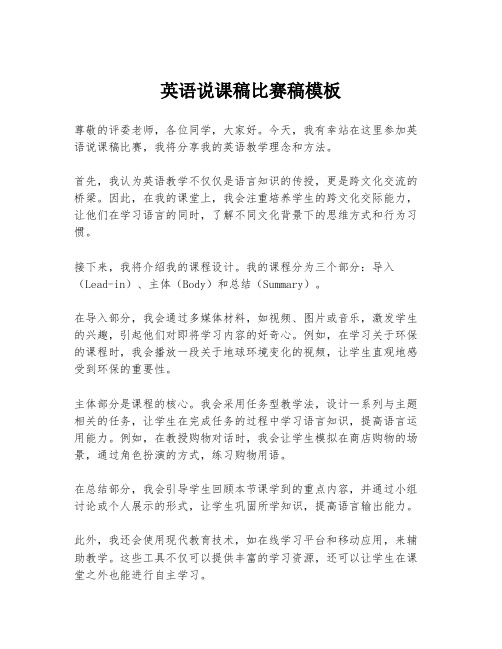
英语说课稿比赛稿模板
尊敬的评委老师,各位同学,大家好。
今天,我有幸站在这里参加英语说课稿比赛,我将分享我的英语教学理念和方法。
首先,我认为英语教学不仅仅是语言知识的传授,更是跨文化交流的桥梁。
因此,在我的课堂上,我会注重培养学生的跨文化交际能力,让他们在学习语言的同时,了解不同文化背景下的思维方式和行为习惯。
接下来,我将介绍我的课程设计。
我的课程分为三个部分:导入(Lead-in)、主体(Body)和总结(Summary)。
在导入部分,我会通过多媒体材料,如视频、图片或音乐,激发学生的兴趣,引起他们对即将学习内容的好奇心。
例如,在学习关于环保的课程时,我会播放一段关于地球环境变化的视频,让学生直观地感受到环保的重要性。
主体部分是课程的核心。
我会采用任务型教学法,设计一系列与主题相关的任务,让学生在完成任务的过程中学习语言知识,提高语言运用能力。
例如,在教授购物对话时,我会让学生模拟在商店购物的场景,通过角色扮演的方式,练习购物用语。
在总结部分,我会引导学生回顾本节课学到的重点内容,并通过小组讨论或个人展示的形式,让学生巩固所学知识,提高语言输出能力。
此外,我还会使用现代教育技术,如在线学习平台和移动应用,来辅助教学。
这些工具不仅可以提供丰富的学习资源,还可以让学生在课堂之外也能进行自主学习。
最后,我相信,通过不断的实践和反思,我们能够找到更适合学生的教学方法,帮助他们更好地掌握英语,享受学习的过程。
感谢大家的聆听,希望我的说课稿能够给大家带来一些启发。
谢谢大家。
大学英语说课稿(定稿)

《大学英语》说课稿各位领导、老师:大家好,我是外语教学部的xx,今天我的说课题目是《大学英语》。
我将就以下几个方面对本课程进行说明:分别为课程定位、主要培养的专业能力和职业素质、课程主要内容、使用的教材和参考的资料、理论和实践教学的课时分配及实施方法、课程的考核方式及对学生评价的方式、教学效果的自我评价等方面。
1、课程定位主要培养的专业能力和职业素质《大学英语》是我院各专业的公共英语必修课,在第一学年开设。
课程宗旨以培养学生在将来工作中所需要的英语应用能力为目标,在帮助学生打好语言基础的同时,重点提高听、说、读、写、译等应用能力,特别是工作过程中的英语交际能力,真正地体现高职公共英语教学的职业性、应用性和实用性。
听的能力:能听懂日常和涉外业务活动中使用的结构简单、发音清楚、语速较慢(每分钟120词左右)的英语对话和不太复杂的陈述,理解基本正确。
说的能力:能用英语进行一般的课堂交际,并能在日常和涉外业务活动中进行简单的交流。
表达比较清楚,语音、语调基本正确。
读的能力:能阅读中等难度的一般题材的简短英文资料,理解正确。
在阅读生词不超过总词数3%的英文资料时,阅读速度不低于每分钟70词。
能读懂通用的简短实用文字材料,如信函、公司简报、合同等,理解正确。
写作能力:能就一般性题材,在30分钟内写出80-100词的命题作文;能填写和模拟套写简短的英语应用文,如填写表格、套写会议议程、通知、信函等,词句基本正确,无重大语法错误,格式恰当,表达清楚。
翻译能力:能借助词典将题材熟悉的文章和对外交往中的一般业务文字材料译成汉语;译文基本流畅,能在翻译时使用适当的翻译技巧。
培养学生职场交际能力,在掌握语言的同时,能够具备职业素质与精神,并在职场中运用英语进行交流。
2、课程主要内容使用的教材和参考的资料本门课程主要讲授:公司组织结构、办公环境、商务就餐、商务旅行、产品设计、贸易运输、客户服务、职场生涯、工作面试等。
本课程是高职高专英语的基础课程,涵盖了不同职业涉外活动中共有的典型英语交际场景,为学生进一步提高英语水平打好基础。
大学英语说课比赛优秀模板

目录
1 2 3 4 5
定位与目标 教学内容 教学实施 教学条件 课程特色
1.定位与目标
1
性质、作用
2
课程目标
1.1 课程定位:性质与作用
大学英语
专业方案
课程体系
必基 修础
职业生涯
个人发展
工拓 具展
传授
语言知识 文化知识
培养
语言技能 交际能力
提升
职业能力 个人素养
1.2 课程目标
模块
视
1
听
说
读
2
写
译
合计
交际功能 交际情景 涉外活动
阅读
写作 翻译
情境与项目
介绍、问候、邀请、道歉 爱好、计划、建议、协议 天气、食物、晚会、旅游 购物、网络、健康、面试 建立贸易关系、产品介绍、参观工
厂、交易会、商务谈判
接待客户、商务宴会、投诉理赔
科技、文化、天文、地理等一般题 材的阅读材料 图表、使用说明书、产品介绍等应 用文的阅读材料 信函、通知、个人简历等英语应用 文 翻译技巧、翻译练习
学时 8×2 8×2 8×2
16×3 16 24 136
2.3 教学内容的表现形式
教材的分析
掌握一定的英语基础知识和技能
互补
21世纪大学
大学实用英语
实用英语
视听说教程
互促
具有一定的听、说、读、写、译的能力
3. 教学实施
1 构建有效的的教学模式 2 使用多元化的教学方法 3 应用现代化的教学手段 4 采用合理化的评价方式
听 说
交际 教学
录展 像示
口 语
情景
听 力
教学
课堂 讲授
英语说课模板(全英文版)——获奖说课稿
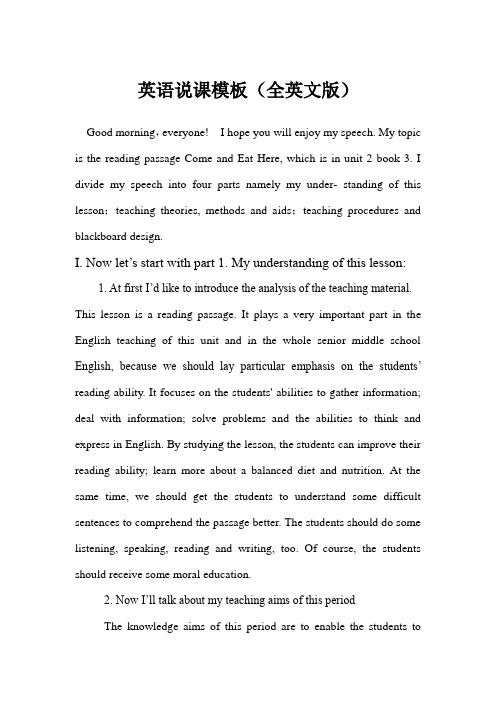
英语说课模板(全英文版)Good morning,everyone! I hope you will enjoy my speech. My topic is the reading passage Come and Eat Here, which is in unit 2 book 3. I divide my speech into four parts namely my under- standing of this lesson;teaching theories, methods and aids;teaching procedures and blackboard design.I. Now let’s start with part 1. My understanding of this lesson:1. At first I’d like to introduce the analysis of the teaching material. This lesson is a reading passage. It plays a very important part in the English teaching of this unit and in the whole senior middle school English, because we should lay particular emphasis on the students’ reading ability. It focuses on the students' abilities to gather information; deal with information; solve problems and the abilities to think and express in English. By studying the lesson, the students can improve their reading ability; learn more about a balanced diet and nutrition. At the same time, we should get the students to understand some difficult sentences to comprehend the passage better. The students should do some listening, speaking, reading and writing, too. Of course, the students should receive some moral education.2. Now I’ll talk about my teaching aims of this periodThe knowledge aims of this period are to enable the students tomaster some useful words and expressions and by the end of the lesson, the students will have a better understanding of the meaning and structure of the text.And developing the students reading ability by fast reading and intensive reading and let them learn different reading skills are the ability aims.For motional aims I’ll stimulate the students’ sense to form a healthy eating habit and develop the students’ sense of cooperative learning.3. In my opinion the teaching important points in this period is how to improve the student’s reading ability.The teaching difficult points for the students are how to understand the text better and how to use the learned phrases and sentences to retell the text.II. Now let’s focus on t he second part about my teaching theories, methods and aids:Before the lesson, we should keep in mind something about students. In my class some students have known something about the topic, because they have talked about it in the previous period ---warming up and speaking. But some long sentences are difficult for them to understand. They don’t often use English to express themselves and communicate with others. Some students are not active in the class because they are afraid of making mistakes. So during the lesson, Iarrange a variety of activities to let all of them join in to attract their interest and let them be confident and taste the joy of success.When I deal with this lesson, I’ll do my best to carry out the theories of the new curriculum, such as task-based teaching and learning; cooperative learning and interactive approach; make the students the real masters in class while I, the teacher acts as director;combine the language structures with the language functions and let the students receive some moral education while they are learning the English language.And I will adopt fast reading to get a general idea of the text and careful reading to get the detailed information; pair or group work to get every student to be active in class; question-and-answer activity teaching method and free discussion method to make the students smooth away the difficulties, and retelling to sum up the whole period.I’ll make full of modern equipment such as the multi-media and tape recorder to make the class more lively and interesting. With the help of the computer and courseware, I think the efficiency of the class will be greatly improved.III. Here comes the most important part, the teaching procedure s:I have designed the following steps to train the students’ ability of listening, speaking, reading and writing, especially reading ability.Step1.RevisionAs it is the second period of this unit, I’ll first check the students’ homework and then get a student to tell the class what a healthy diet contains. Thus I can offer a chance for the students to review the content in the first period.Step2.Lead-inI will lead in the topic of the unit by showing the students a short film about healthy eating, in which a fat man and a thin man are eating different kind of diet, and they are both unhealthy. And then discuss the following questions to lead in the topic:What kind of food does each man like?Are they healthy? Why?Through this activity I can arouse the students’ interest of study and bring in new subject.Step3.Prediction for readingI’ll get the students to look at the title and the pictures and guess what the text might be about .It draw the students’ attention to the contain of the text..Step4. Fast readingAsk the students to read the passage quickly and get the main idea and the structure of text. Guide the students to find out key words and sentences or pay attention to the first sentences of each paragraph to getthe main idea and the structure of the text.By doing this, I will train the students for fast reading skills to improve the students’ reading ability and let the students understand the general idea of each paragraph.Step5. Intensive readingThe students are required to focus on the whole text carefully paragraph by paragraph to locate particular information and finish the exercises on the screen. These exercises are mainly sentence judgments, choices about the text. They are designed from the easiest one to the most difficult one for different levels' Ss. The purpose is to train the students for the skills of scanning and to lead the students to find out the important facts and detailed information. I’ll ask the students to finish the exercises by cooperation and competitions. They can first help each other under- stand the text and smooth away the difficulties. Then I'll divide the Ss into 4 groups. If a student can answer the question correctly, then his/ her group can get one point. And the group which gets the most points is the winner. Only through cooperation can the Ss taste the joy of success. If the Ss know their answer is right, he'll be confident and they'll surely become more enthusiastic in learning English. The purpose is to improve the students’ reading comprehension. And at the same time the students can become aware of the happiness of helping each other. Thus the students receive some moral education.Step 6.Discussion:For the students to understand the passage better, I will get the students to have a discussion in groups about the questions:1. What are the weakness and strength of the diet in Wang Peng’s and Yong Hui’s restaurant?2. What do you think Wang Peng will provide to win his customers back.These questions are based on the understanding of the passage and it can get the student to imagine the end of the story. They are open-ended questions, so the student can provide various answers. By doing so, I guide the students to activate their language that they have learned. Then invite some group members to report their work to the whole class to make them overcome their shyness and stimulate them to speak in public.I think the ability to use English is the most important. We spend so long studying English. We s houldn’t end it just by attending the English entrance examination to get high marks. I gave the Ss some presents because of their excellent performances, thus enhancing their awareness of using English.Step7. ListeningPlay the tape of the passage for the students to listen and follow. Then ask them to read the text aloud. Tell them to pay attention to the pronunciation and intonation. At the some time, they can enjoy the beautyof the English language. And it can prepare the students for the retelling the text in the next step.Step8.Summary and retelling the textSince the students in the class are in different levels, first I will let them to fill in the blank to get an expression of the general idea of the text. And I’ll ask the students to retell the story in their own words.Step9. HomeworkAt the end of the lesson, I’ll tell the students to copy the useful phrases and sentences they like in their notebook and retell the passage and write it down in their own words.I think homework is important. It is necessary for the students to do some extensive exercises after class to consolidate the knowledge they learned. I want to improve the ability of their writing. At the same time, train the ability of do-it-yourself.IV. Part 4. Blackboard designAt last, let me show you my blackboard design: The title is in the middle. Below it are the main ideas of each paragraph on the left of it are some language points mentioned in this period and on the right is the result of the competition,The Blackboard Design is to let the Ss have a clear idea to get the main content of this period, and it should be clear and artful.In this lesson, I lead the students understand the passage step by step,and help them to retell the text. In the whole period I just act as a director, giving the students some detailed task and letting the students explore the knowledge by themselves or in teamwork. The students are very active, and I fulfill the teaching aims very well. But there are some new language points in the passage, so I will explain them for the students next period.Thank you for listeningBlackboard design:。
(完整版)大学英语说课模板

Good afternoon, teachers. It’s my great pleasure to be here sharing my teaching ideas with you. The content of my lesson is Fable of the Lazy Teenager, Unit 8 Educational Problems of the New College English Integrated Course Book 1.I’ll begin the lesson from the following four parts:Analyzing teaching materialThe teaching methodsThe studying methodsThe teaching proceduresOk now I am going to start from the first part “Analyzing teaching material”This text is about American educational problems complaining of American teenagers’ lack of interest in learning.The teaching aim of this lesson is to help students to understand the structure of the text and learn to apply cause-and-effect relationship to improve their essay writing.The ability aim is to improve the students’ organizing and using skills of English and to retell the whole text in their own words.The emotional aim is to help students understand the importance of education and to develop students’ sense of learning.Then the teaching key points is to help the students get a general idea of the whole passage and to grasp the main idea of each part. And the teaching difficult points is to make students understand and apply cause-and-effect analysis.According to the analysis above, I’ll try my best to carry out the following theories while dealing with this lesson:The first teaching method I will use is communicative approach, since language is used for communication. Communicative approach is learner-centered and emphasizes communication and real-life situations.The second teaching method I would like to use is task-based approach. A task resembles activities which our students or other people carry out in everyday life. Learners should be given opportunities to reflect on what they have learned and how well they are doing.And in order to practice my teaching methods better, the following teaching aids will be used: Aprojector, multimedia and of course the blackboard.And then, I would like to talk about the studying methods. My students are non-English majors and they are freshmen majoring in mechanical design, manufacturing and automation. As students are poor in cooperative learning skill, many students are not active in English class, and even some of them don’t like English. Therefore, I will have the students learn English in a much more relaxed atmosphere. The learning process of students is from seeing, thinking, and speaking.Next, I will talk about the teaching procedure. To train the students’ ability of speaking, reading and writing, I have designed the following steps.Step 1 Lead-inAt the very beginning of the class, I will present the students pictures related to the theme of the text And of course I will divide students into several groups to discuss the questions related. The purpose of this step is to arouse the students’ learning interest. After that, it’s the very time to naturally lead the class to the text.Step 2 Global analysis of the textIn this step, I will guide students The purpose of this step is to train and improve the students’reading ability.Step 3 skimming and scanningIn this step, I will give the students two tasks . The first task is to get the general idea, the task is to develop the students’ reading skill by making prediction and to encourage the students to express their own thoughts in English. The second task is to get the main idea of each paragraph. I will divide the whole class into several groups to skim the whole text and get the main idea of each paragraph. The purpose of this task is to improve the students’ fast reading skill and cooperate with each other.And then guide Ss to read the material carefully and take some important notes, then answer the following questions in P.Step 4 Retelling the passageLanguage is learned by communicatin g. It’s my job to creat an atmosphere for students to use the language. The students discuss in their group and then choose a reporter to share to the whole class. Step 7 ConsolidationIn this activity, I will ask some students to read each paragraph, and then do the exercise followingthe text.Step 8 make a summaryI will go through the important points and difficult points of this lesson with the students once again. And of course, the language points on the blackboard will be mentioned as well.And now let’s move to the last stepStep 9 Homework1.Read the passage as frequently as you can2.Find out some words and sentences you think are beautiful and recite them.Purpose of my design: Homework is so important and necessary for to master the knowledge they learned after class. It will check whether the Ss achieve the teaching aims.That’s all of my teaching ideas about this lesson. Thanking you for your listening.。
大学英语说课模板
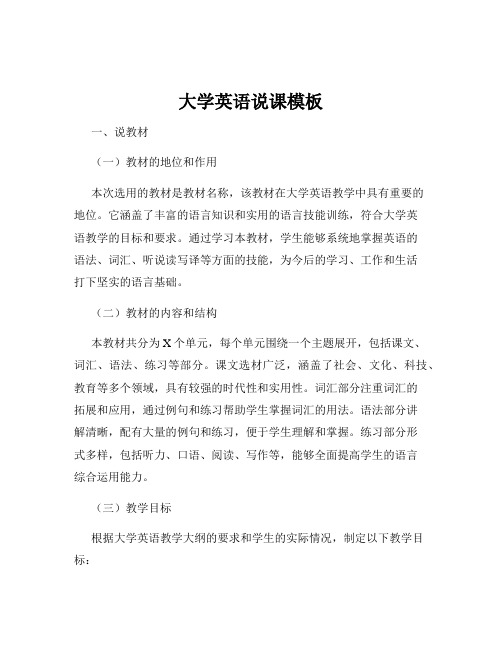
大学英语说课模板一、说教材(一)教材的地位和作用本次选用的教材是教材名称,该教材在大学英语教学中具有重要的地位。
它涵盖了丰富的语言知识和实用的语言技能训练,符合大学英语教学的目标和要求。
通过学习本教材,学生能够系统地掌握英语的语法、词汇、听说读写译等方面的技能,为今后的学习、工作和生活打下坚实的语言基础。
(二)教材的内容和结构本教材共分为X个单元,每个单元围绕一个主题展开,包括课文、词汇、语法、练习等部分。
课文选材广泛,涵盖了社会、文化、科技、教育等多个领域,具有较强的时代性和实用性。
词汇部分注重词汇的拓展和应用,通过例句和练习帮助学生掌握词汇的用法。
语法部分讲解清晰,配有大量的例句和练习,便于学生理解和掌握。
练习部分形式多样,包括听力、口语、阅读、写作等,能够全面提高学生的语言综合运用能力。
(三)教学目标根据大学英语教学大纲的要求和学生的实际情况,制定以下教学目标:1、知识目标掌握教材中的重点词汇和短语,能够正确运用。
掌握教材中的重点语法结构,能够熟练运用。
理解课文的内容和主旨,能够回答相关问题。
2、技能目标能够听懂与课文主题相关的英语材料,理解主要内容。
能够用英语进行简单的日常交流,表达自己的观点和想法。
能够阅读与课文难度相当的英语文章,获取主要信息。
能够用英语写一篇与课文主题相关的短文,表达自己的观点和看法。
3、情感目标激发学生学习英语的兴趣,培养学生的学习积极性和主动性。
培养学生的跨文化交际意识,提高学生的文化素养。
培养学生的团队合作精神和自主学习能力。
(四)教学重难点1、教学重点重点词汇和短语的用法,如列举重点词汇和短语。
重点语法结构的运用,如列举重点语法结构。
课文的理解和掌握,包括课文的主旨、细节和语言特点。
2、教学难点某些复杂语法结构的理解和运用,如列举复杂语法结构。
如何引导学生用英语进行有效的交流和表达。
如何培养学生的自主学习能力和跨文化交际意识。
二、说教法(一)教学方法的选择为了实现教学目标,突破教学重难点,在教学过程中采用了多种教学方法,如讲授法、讨论法、练习法、情景教学法等。
大学英语说课比赛一等奖说课稿范文

大学英语说课比赛一等奖说课稿范文全文共6篇示例,供读者参考篇1Hello everyone! My name is Lily and I'm 8 years old. Today I want to talk to you about something very important - learning English!You might be wondering why learning English is so great. Well, let me tell you! English is one of the most widely spoken languages in the world. That means if you can speak English, you can talk to people from lots of different countries and make new friends all over the world!Another reason English is awesome is because of all the cool books, movies, TV shows, games and websites that are in English. If you know English, you can read the latest Harry Potter book, watch your favorite Disney movie without subtitles, and play video games without having to guess what the words mean. How neat is that?But learning a new language can be pretty hard, right? Don't worry, I'm going to share some tips with you on how to learn English easily and have fun doing it!Tip #1: Listen to English every dayOne of the best ways to get better at English is to listen to it as much as you can. You can listen to English songs, watch English TV shows or movies, or even just have English audio books playing when you're doing other activities. The more you hear English being spoken, the easier it will be for your brain to get used to how it sounds.Tip #2: Learn new words by labeling thingsAnother great trick is to start labeling everyday objects around your house with English words. You can use sticky notes to label things like "door", "chair", "table", "book", etc. Every time you see that object, your brain will connect the English word with the thing itself. It's like giving your brain a teeny reminder of the vocabulary!Tip #3: Play English gamesWho doesn't love games? Well, there are lots of fun English learning games you can play that will help you practice without even realizing you're studying. There are board games, card games, video games, apps...you name it! My personal favorite is an app called Duolingo. It's like a little English teacher who lives in your phone or tablet.Tip #4: Read, read, read!Reading is so important for getting better at English. You can start with very simple books that have lots of pictures to help explain the words. As you get better, you can move on to harder books. Reading out loud is a great way to practice your pronunciation too. Ask your parents or teachers for recommendations on good English reading materials for your level.Tip #5: Don't be afraid to make mistakesListen up, this one is very important! The key to learning any new language is to not be scared to make mistakes. Everyone makes mistakes when they're first starting out speaking English. But that's okay! The more you practice, even if you make lots of silly mistakes at first, the better you'll get. Your brain is like a muscle - the more you exercise it with English, the stronger it will become.Tip #6: Find a language partnerHaving a friend to practice English with is super helpful and fun. You can take turns coming up with silly sentences in English. You can make up jokes or stories together. And you can remind each other when someone makes a mistake, but in a nice,supportive way of course! Your parents can also practice conversational English with you.Tip #7: Be patient and keep practicingLearning a new language takes time and hard work. There will be days when you feel frustrated because English seems really difficult. That's normal! The important thing is to not give up. Keep listening, reading, speaking, and writing in English as much as you can, even when it's hard. Over time, it will start to feel much more natural. Trust me!So those are my top tips for learning English easily as a kid. The key things to remember are: have fun with it, don't be afraid to make mistakes, and keep on practicing every single day. Before you know it, English will start to feel like your second language.I'm going to leave you with one of my favorite English quotes: "You have brains in your head, you have feet in your shoes, you can steer yourself any direction you choose!" That's from the Dr. Seuss book Oh, The Places You'll Go. With English skills, you really can go absolutely anywhere in the world. So what are you waiting for? Let's get started learning English together!Thank you all for listening! Let me know if you have any other questions.篇2Hi everyone! My name is Timmy and I'm 8 years old. Today I want to tell you all about my favorite person in the whole wide world - my big brother Tommy!Tommy is 12 years old and the coolest big brother ever. He's really good at sports like baseball and soccer. Whenever we play together in the backyard, he always lets me score some goals and helps me get better. That's because Tommy is a great teacher too!You see, Tommy is really smart and gets good grades in school. He's especially good at English. Tommy loves reading books and can speak English like a grown-up! Sometimes he helps me with my English homework when I get stuck. He's way better at explaining things than my teacher.One of the funnest things about having Tommy as a big brother is he always makes me laugh with his funny jokes and silly voices. Like when we're playing pretend, he'll speak in a really deep voice as the evil dragon or a high-pitched squeak as a little mouse. It cracks me up every time!But Tommy isn't just a jokester. He's also really kind and caring. Like this one time when I fell off the monkey bars at the park and scraped my knee, he helped bandage me up. He even gave me his favorite Superman band-aid because he knew how much I love Superman.When I'm feeling sad or upset about something, Tommy is always there to cheer me up and make me feel better. Like last year when our dog Buddy ran away, I was crying so much. But Tommy hugged me tight and told me not to worry, that we'd find Buddy for sure. And you know what? We did find Buddy a couple days later!I love how Tommy makes time for me and plays with me, even though he's older and has lots of friends his own age. We have awesome pillow fights and build amazing blanket forts together. Sometimes he lets me hang out with his friends too, which is really cool. They all think Tommy is the best.I try my best to be a good little brother to Tommy too. I always cheer really loud for him at his baseball games. And I make sure to keep his room clean and not mess with his stuff. Well, most of the time anyway! What can I say, being a pesky little brother is part of the job description.More than anything though, I just love how much fun Tommy and I have together. We joke around, play games, and just enjoy being kids without any worries. We're total goofballs! Our parents are always telling us to quiet down because we get so loud and giggly. Haha!I feel really lucky to have such an amazing big brother. Tommy teaches me, takes care of me, makes me laugh, and is just an all-around awesome friend. He's the best role model a little kid could ask for.When I grow up, I want to be just like Tommy - smart, athletic, funny and kind. He's set the bar super high, but I'll do my best to follow in his footsteps. I hope that one day if I have a little brother or sister, I can be as wonderful a big sibling as Tommy is to me.So there you have it, my big brother Tommy is the kindest, coolest, most fun person I know. He's my hero and best friend, all rolled into one. Here's to you Tommy - thanks for being the world's greatest big bro!篇3Hi everyone! My name is Lily and I'm 8 years old. Today I want to talk to you about one of my favorite topics - animals! Ilove learning about all the different creatures that live on our planet.Did you know there are over 8 million different species of animals in the world? That's a really, really big number! From the tiny ants crawling on the ground to the huge blue whales swimming in the ocean, animals come in so many amazing shapes and sizes.Some animals are really cute and cuddly, like puppies, kittens, and bunnies. Others might seem scary at first, like bears, lions, and sharks. But even the biggest, toughest animals are actually gentle giants if you get to know them. My dad says you shouldn't judge an animal by how it looks on the outside.Speaking of how animals look, they come in pretty much every color of the rainbow! You've got bright red cardinals, orange clownfish, yellow canaries, green frogs, blue butterflies, purple horses, and even animals that are different shades like brown bears and black panthers. Isn't that incredible? It's like a giant living rainbow!Animals also have some crazy features that help them survive in the wild. Like ducks have webbed feet to help them swim. Camels have humps filled with fat to provide them energy.And porcupines have cool quills all over their backs to protect them from predators. How neat is that?My favorite animals to learn about are definitely thefunny-looking ones. Like the blobfish, which is one of the ugliest animals ever with its grumpy frown and floppy body. Or the star-nosed mole, which has the craziest nose that looks like a rainbow star! Those animals always make me laugh.Some animals are really good at special talents too. Like monkeys who can climb trees really fast. Dolphins that can jump and do flips out of the water. Birds that can fly for hundreds of miles during migration seasons. And my dog Buster is a champion at catching frisbees!Sadly though, there are some animals that are going extinct and disappearing from the planet forever. Usually it's because humans are damaging their homes or polluting the environment. It makes me really sad to think of beautiful animals like pandas, polar bears, and gorillas no longer existing one day. We need to take better care of the Earth so animals have places to live safely.That's why I try my best to protect animal habitats and be an environmentalist. I always recycle my bottles, cans, and paper. I turn off lights when I leave a room to save electricity. And I pickup any trash I see on the ground so it doesn't get washed into rivers or oceans. Every little bit helps the animal world!I could probably talk about animals all day because they're just so fascinating. From the Great Barrier Reef filled with colorful fish and sea creatures to the African savannah where herds of zebras, elephants, and giraffes roam, our planet is home to such an incredible variety of life. And who knows, maybe I'll grow up to become a zoologist or animal rescuer someday!Well, that's about all I've got for today's speech. Thanks for listening, guys! Let's give a round of applause for all the awesome animals out there. Doesn't matter if you've got fur, feathers, scales, or anything else - you're all amazing in my book. Let's keep exploring and learning about the wonderful world of wildlife!篇4Hi everyone! My name is Timmy and I'm 8 years old. Today I'm going to give a lecture about one of my favorite topics - animals!I love learning about all the different kinds of animals in the world. There are so many cool ones with special abilities! Likechameleons that can change colors, or octopuses that can squeeze through tiny spaces.But today I want to talk about my very favorite animal - the elephant! Elephants are the biggest land animals on Earth. An adult elephant can weigh over 6 tons! That's as much as 4 cars. They are so strong that they can even use their trunks to push down entire trees.Elephant trunks are amazing. A trunk is a long nose that the elephant uses like an arm to grab things. It has over 40,000 muscles in it! An elephant can use its trunk to pick up logs, pull up grass to eat, or even take a drink of water and spray it in its mouth. Pretty cool, right?Elephants are also really smart animals. They have huge brains that weigh around 11 pounds. That's as big as a large bowling ball! Elephants can recognize themselves in mirrors and they almost never forget anything. Some elephants can even learn to follow commands and do cool tricks.But being so big and strong doesn't mean elephants are mean animals. Most of the time, elephants are very gentle giants that just want to eat leaves and play with their families. Baby elephants are especially cute - they weigh around 200 pounds when they're born but will grow up to over 6,000 pounds!Elephants are found mostly in Africa and parts of Asia. In the wild, they live together in big groups led by the oldest female elephant. She's called the matriarch and she decides when and where the herd will travel to find food and water. Elephants have to eat almost constantly - an adult elephant can eat up to 300 pounds of food per day!Elephants use their trunks as snorkels when they swim under water. They can hold their breath for up to 6 minutes at a time! Swimming cools elephants off since they live in hot climates. After swimming and taking mud baths, elephants will spray dirt on their bodies to help keep them from getting too hot in the sun.Sadly, there are not as many elephants in the world as there used to be. Hunters used to kill elephants for their huge ivory tusks to sell. Without enough elephants, the balances in some ecosystems was disrupted, meaning other plants and animals were affected too.Now, there are laws protecting elephants so poachers can't hunt them. But habitat loss from deforestation and human settlements is still a big problem for elephants. We need to protect their forest homes so they have places to roam, eat, and take care of their babies.I think all kids should learn about how amazing elephants are and why we need to make sure they never go extinct. Elephants are such intelligent, gentle, family-oriented animals. Just watching videos of baby elephants playing and running around with their moms makes me smile every time.Once when I went to the zoo, I got to feed an elephant a bunch of carrots, lettuce, and fruit using a stick to put the food right into its trunk. The elephant could pick up an entire watermelon with its trunk! It was one of the coolest experiences ever.In the future, I hope I can maybe work as a researcher at an elephant sanctuary. Or if not that, as a ranger protecting elephants in Asia or Africa. I would get to see elephant herds travelling together every day and learn even more about how they communicate, raise babies, and survive in their environments.Elephants have been around for millions of years. With all the challenges they face from poaching and habitat loss, we need to make sure they don't disappear from our planet forever. They are such special, intelligent animals that every kid and adult should appreciate. Even if you've never seen a real elephant, youcan't help but smile at pictures and videos of their long trunks, big floppy ears, and funny running!Thanks for listening to me talk about my favorite animal, the elephant. I hope you learned just how amazing these giants really are. Let's make sure to protect their habitats so elephants can stick around for many, many more millions of years!篇5Hi everyone! My name is Lucy and I'm 8 years old. Today I want to teach you all about animals! Animals are really cool and there are so many different types. Let's start by talking about pets.Pets are animals that live with people in their homes. The most popular pets are dogs and cats. I have a dog named Buddy who is a golden retriever. He's really friendly and loves to play fetch. Cats make good pets too but some people are allergic to them. Other common pets are fish, birds, rabbits, hamsters, and guinea pigs.Now let's move on to farm animals. These are animals that live on farms and help farmers. Cows are big animals that provide us with milk and beef. Chickens give us eggs and their meat is called chicken. Pigs are raised for their meat called porkor bacon. Sheep provide wool for clothing and milk. Horses are very strong and can pull plows or carry people.Next up are wild animals that live in nature. These animals aren't pets and most aren't tamed. Bears are large, furry animals that live in forests. They love honey and fish. Deer are graceful animals with antlers that run very fast. Wolves are related to dogs but are not tamed. They live in packs led by an alpha male and female. Lions are big cats that live in prides and are the king of the jungle!Marine animals live in the ocean. Whales are the largest animals on Earth and some can sing beautiful songs. Dolphins are very smart and can do tricks at aquariums. Sharks have lots of sharp teeth and some species are dangerous to humans. Sea turtles are reptiles with hard shells that migrate long distances. Other cool marine animals are octopuses, seahorses, and jellyfish.There are some really weird animals out there too! The platypus is a strange Australian mammal that is venomous and lays eggs. The aye-aye is a lemur with rodent-like teeth and a creepy long finger for finding food. And the naked mole rat looks almost alien with its wrinkly, hairless body!I hope you all learned something new about the amazing creatures we share this planet with. Animals come in so many different shapes, sizes, and habitats. My favorite is probably the red panda because they're so cute and fluffy! What's your favorite animal? Let me know!篇6Hi everyone! My name is Emma and I'm 10 years old. Today I want to teach you all about pets! Having a pet is lots of fun and can teach you responsibility too.First, let's go over some common pets people have. The most popular pet is probably dogs. Dogs come in all shapes and sizes - from tiny Chihuahuas to huge Great Danes! Some dogs were bred to herd sheep, like Border Collies. Others were bred to be lap dogs and companions, like Poodles. No matter what kind, dogs make great pets because they are loyal, loving, and energetic.Cats are another very common pet. They are usually lower maintenance than dogs since they can be left alone more easily. Cats love to play with toys like fake mice and laser pointers. They are also expert nappers and can sleep up to 16 hours a day!Popular cat breeds include the Siamese, Persian, and Maine Coon.Fish are a good "starter pet" for young kids to learn responsibility. Instead of a bowl, fish should live in a proper tank with a filter and heater. Some easy fish are guppies, goldfish, and bettas. You have to be careful not to overfeed them and to keep their tank clean.Birds like parakeets, cockatiels, and parrots can make fun pets too. They are very social and some can even talk! However, they make a lot of noise and require a large。
大学英语说课稿教案模板

一、课程名称:大学英语综合教程二、授课班级:XX级XX班三、授课教师:[教师姓名]四、授课时间:[具体日期]五、教学目标:1. 知识目标:- 理解并掌握本节课的生词和短语。
- 熟悉并理解课文内容,提高阅读理解能力。
- 掌握课文中的语法点。
2. 能力目标:- 培养学生的英语听说能力,提高口语表达能力。
- 培养学生的英语写作能力,提高写作水平。
- 培养学生的自主学习能力,提高学习效率。
3. 情感目标:- 激发学生对英语学习的兴趣,培养学生良好的学习习惯。
- 培养学生的跨文化交际意识,提高学生的综合素质。
六、教学重点:- 本节课的生词和短语。
- 课文内容中的关键信息和细节。
- 课文中的语法点。
七、教学难点:- 生词和短语的运用。
- 课文的深入理解。
- 语法点的灵活运用。
八、教学过程:1. 导入(5分钟):- 利用多媒体展示与课文相关的图片或视频,激发学生的学习兴趣。
- 提出与本节课内容相关的问题,引导学生进行思考和讨论。
2. 新课导入(15分钟):- 预习课文,引导学生总结课文大意。
- 针对课文中的生词和短语进行讲解,帮助学生理解和记忆。
- 分析课文中的语法点,讲解语法规则。
3. 课堂活动(20分钟):- 进行小组讨论,让学生在合作中学习,提高口语表达能力。
- 设计课堂练习,巩固学生对课文知识的掌握。
- 进行角色扮演,让学生在实际情境中运用所学知识。
4. 课堂小结(5分钟):- 总结本节课的重点内容,帮助学生梳理知识。
- 鼓励学生在课后进行复习和巩固。
5. 作业布置(5分钟):- 布置课后作业,包括课文背诵、单词记忆、语法练习等。
九、教学反思:- 教师应根据学生的实际情况调整教学策略,提高教学效果。
- 注重培养学生的自主学习能力,提高学生的综合素质。
- 关注学生的情感需求,营造良好的学习氛围。
十、教学资源:- 教材、多媒体课件、网络资源等。
十一、教学评价:- 通过课堂提问、小组讨论、作业完成情况等评价学生的学习效果。
英语大赛说课稿范文模板

英语大赛说课稿范文模板尊敬的评委老师,各位同学,大家好!今天,我有幸在这里与大家分享我的英语教学理念和方法。
我将从教学目标、教学内容、教学方法、教学过程、评价方式以及教学反思六个方面,对即将进行的英语课程进行说课。
一、教学目标本节课的教学目标是让学生掌握一定数量的英语词汇和基本句型,提高他们的英语口语表达能力,同时激发他们学习英语的兴趣。
二、教学内容本节课的教学内容主要包括以下几个部分:日常用语的学习、简单对话的练习、以及英语文化背景的介绍。
三、教学方法为了达到教学目标,我将采用情景教学法、任务型教学法和合作学习法。
情景教学法可以让学生在模拟的语境中学习语言,任务型教学法则通过完成具体的任务来提高语言运用能力,而合作学习法则鼓励学生之间的交流与合作。
四、教学过程1. 导入新课:通过播放一段与本节课主题相关的视频,激发学生的兴趣,并引入新课的主题。
2. 词汇教学:通过图片、实物和动作演示,教授新词汇,确保学生能够正确发音和理解词义。
3. 对话练习:设计情景对话,让学生在小组内进行角色扮演,练习使用新学的词汇和句型。
4. 文化介绍:简要介绍与本节课相关的英语国家文化,拓宽学生视野。
5. 课堂小结:总结本节课的重点内容,鼓励学生进行自我反思。
五、评价方式本节课的评价方式将包括课堂表现、小组合作情况、以及课后作业的完成情况。
通过多元化的评价方式,全面了解学生的学习效果。
六、教学反思课后,我将根据学生的反馈和课堂表现,对教学方法和内容进行反思和调整,以期达到更好的教学效果。
最后,我相信通过本节课的学习,学生们不仅能够学到实用的英语知识,还能够提升自己的跨文化交流能力。
谢谢大家!(结束语)再次感谢各位评委老师和同学们的聆听,我期待与大家共同探讨和进步。
谢谢大家!。
大学英语说课模板
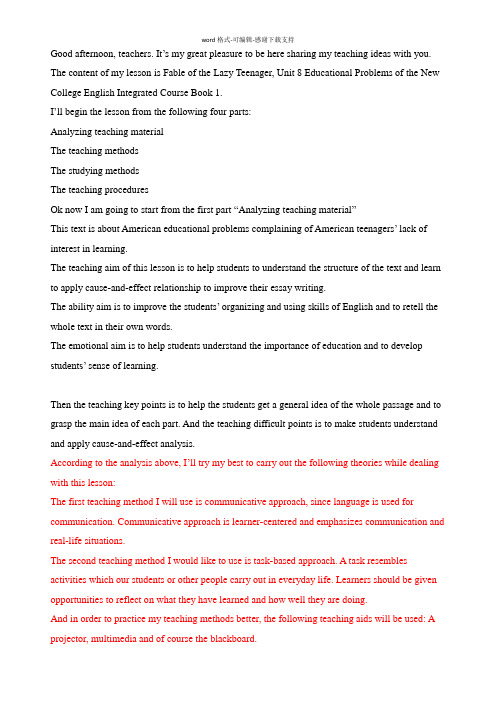
Good afternoon, teachers. It’s my great pleasure to be here sharing my teaching ideas with you. The content of my lesson is Fable of the Lazy Teenager, Unit 8 Educational Problems of the New College English Integrated Course Book 1.I’ll begin the lesson from the following four parts:Analyzing teaching materialThe teaching methodsThe studying methodsThe teaching proceduresOk now I am going to start from the first part “Analyzing teaching material”This text is about American educational problems complaining of American teenagers’ lack of interest in learning.The teaching aim of this lesson is to help students to understand the structure of the text and learn to apply cause-and-effect relationship to improve their essay writing.The ability aim is to improve the students’ organizing and using skills of English and to retell the whole text in their own words.The emotional aim is to help students understand the importance of education and to develop students’ sense of learning.Then the teaching key points is to help the students get a general idea of the whole passage and to grasp the main idea of each part. And the teaching difficult points is to make students understand and apply cause-and-effect analysis.According to the analysis above, I’ll try my best to carry out the following theories while dealing with this lesson:The first teaching method I will use is communicative approach, since language is used for communication. Communicative approach is learner-centered and emphasizes communication and real-life situations.The second teaching method I would like to use is task-based approach. A task resembles activities which our students or other people carry out in everyday life. Learners should be given opportunities to reflect on what they have learned and how well they are doing.And in order to practice my teaching methods better, the following teaching aids will be used: A projector, multimedia and of course the blackboard.And then, I would like to talk about the studying methods. My students are non-English majors and they are freshmen majoring in mechanical design, manufacturing and automation. As students are poor in cooperative learning skill, many students are not active in English class, and even some of them don’t like English. Therefore, I will have the students learn English in a much more relaxed atmosphere. The learning process of students is from seeing, thinking, and speaking.Next, I will talk about the teaching procedure. To train the students’ ability of speaking, reading and writing, I have designed the following steps.Step 1 Lead-inAt the very beginning of the class, I will present the students pictures related to the theme of the text And of course I will divide students into several groups to discuss the questions related. The purpose of this step is to arouse the students’ learning interest. After that, it’s the very time to naturally lead the class to the text.Step 2 Global analysis of the textIn this step, I will guide students The purpose of this step is to train and improve the students’reading ability.Step 3 skimming and scanningIn this step, I will give the students two tasks . The first task is to get the general idea, the task is to develop the students’reading skill by making prediction and to encourage the students to express their own thoughts in English. The second task is to get the main idea of each paragraph.I will divide the whole class into several groups to skim the whole text and get the main idea of each paragraph. The purpose of this task is to improve the students’fast reading skill and cooperate with each other.And then guide Ss to read the material carefully and take some important notes, then answer the following questions in P.Step 4 Retelling the passageLanguage is learned by communicatin g. It’s my job to creat an atmosphere for students to use the language. The students discuss in their group and then choose a reporter to share to the whole class.Step 7 ConsolidationIn this activity, I will ask some students to read each paragraph, and then do the exercise following the text.Step 8 make a summaryI will go through the important points and difficult points of this lesson with the students once again. And of course, the language points on the blackboard will be mentioned as well.And now let’s move to the last stepStep 9 Homework1.Read the passage as frequently as you can2.Find out some words and sentences you think are beautiful and recite them.Purpose of my design: Homework is so important and necessary for to master the knowledge they learned after class. It will check whether the Ss achieve the teaching aims.That’s all of my teaching ideas about this lesson. Thanking you for your listening.。
大学英语一等奖说课稿演示文稿

大学英语
专业英语
第二十四页,共30页。
3.3 学生风采
高中英语
学习
大学英语
专业英语
第二十五页,共30页。
3.3 学生风采
高中英语 学习
大学英语
专业英语
第二十六页,共30页。
3.4 课程管理
1.实施集体备课,统一教案编写; 2.合理安排教学进度
包括:课程介绍;教学大纲及考试大纲;教学方 法高及中教英语学手段;授课计划;授课教案;电子教案 ;作学业习 习题;试题库大;学英课语程考核。 专业英语
第十页,共30页。
2.4 教学条件
1.师资:博士1名、副教授2名 ,讲师8名,其中海归教师3 名,基本实现全硕士 2.硬件设备:语音室、多媒 体教室、自主学习室
3.图书馆 4.资料室
第十一页,共30页。
2.5 内容定位
知识点 高中英语
学习
能力点
大学英语
素质点
专业英语
第十二页,共30页。
2.6 重点、难点
第十三页,共30页。
2.7教学方法
1.交际教学法 2.任务型教学法
3.角色表演法 4.多媒体辅助教 学
第十四页,共30页。
教学活动掠影
第十五页,共30页。
教学活动掠影
第十六页,共30页。
教学活动掠影
第十七页,共30页。
2.8 课程考核
平时成绩
30%
出勤、课堂表现 、课外自主学习
和作业
考试成绩
重点:
1.传统英语教学法与当代英语教学法相结合。区别对 待教学中的大量语言材料。 2.教学过程中,以学生为中心,让学生积极参与课堂教学
活动,增强学生独立思考与解决问题的能力,培养他们的 创新意识与创新能力。
大学英语说课模板

大学英语说课模板一、说教材(一)教材的地位和作用本次说课所选用的教材是_____出版的《大学英语》。
这套教材在大学英语教学中被广泛使用,具有系统性、科学性和实用性等特点。
本单元的主题是_____,通过对这一主题的学习,学生能够掌握相关的英语词汇、语法和表达,同时提高英语听说读写的综合能力。
此外,该主题与学生的日常生活和未来职业发展密切相关,能够激发学生的学习兴趣和积极性。
(二)教学目标根据大学英语课程的要求和学生的实际情况,我制定了以下教学目标:1、知识目标学生能够掌握本单元的重点词汇和短语,如_____、_____等。
学生能够理解并正确运用本单元的重点语法结构,如_____、_____等。
2、技能目标提高学生的英语听说能力,使学生能够听懂与本单元主题相关的英语对话和短文,并能够进行简单的英语交流。
培养学生的英语阅读和写作能力,使学生能够阅读并理解与本单元主题相关的英语文章,并能够用英语撰写简单的短文。
3、情感目标激发学生学习英语的兴趣和积极性,培养学生的自主学习能力和合作学习精神。
增强学生的跨文化意识,提高学生的综合素质。
(三)教学重难点1、教学重点本单元的重点词汇、短语和语法结构。
与本单元主题相关的英语听说读写技能的训练。
2、教学难点如何帮助学生正确运用重点语法结构进行英语表达。
如何提高学生的英语阅读理解和写作能力。
二、说教法为了实现教学目标,突破教学重难点,我将采用以下教学方法:1、情景教学法通过创设生动有趣的情景,让学生在真实的语境中学习和运用英语,提高学生的语言运用能力。
2、任务驱动法给学生布置具体的学习任务,让学生在完成任务的过程中掌握知识和技能,培养学生的自主学习能力和合作学习精神。
3、讲授法对于重点和难点知识,我将进行详细的讲解和分析,帮助学生理解和掌握。
4、练习法通过课堂练习和课后作业,让学生巩固所学知识,提高学生的英语应用能力。
三、说学法在教学过程中,我将注重培养学生的自主学习能力和合作学习精神,引导学生采用以下学习方法:1、自主学习法让学生在课前预习教材内容,查阅相关资料,培养学生的自主学习能力。
全英文说课模板(精华版)
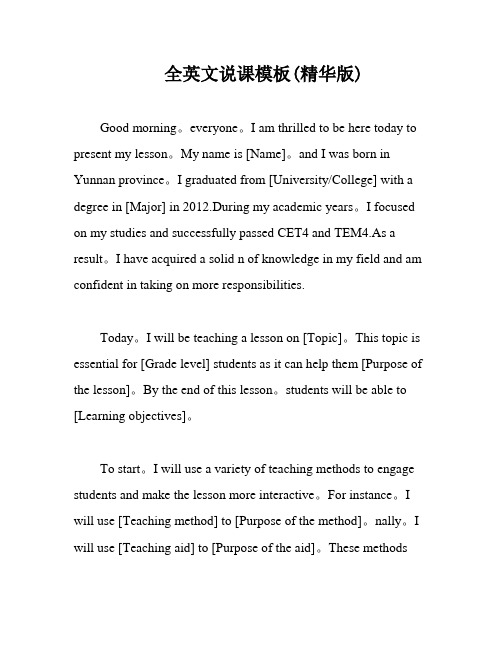
全英文说课模板(精华版)Good morning。
everyone。
I am thrilled to be here today to present my lesson。
My name is [Name]。
and I was born in Yunnan province。
I graduated from [University/College] with a degree in [Major] in 2012.During my academic years。
I focused on my studies and successfully passed CET4 and TEM4.As a result。
I have acquired a solid n of knowledge in my field and am confident in taking on more responsibilities.Today。
I will be teaching a lesson on [Topic]。
This topic is essential for [Grade level] students as it can help them [Purpose of the lesson]。
By the end of this lesson。
students will be able to [Learning objectives]。
To start。
I will use a variety of teaching methods to engage students and make the lesson more interactive。
For instance。
I will use [Teaching method] to [Purpose of the method]。
nally。
I will use [Teaching aid] to [Purpose of the aid]。
英语大赛说课稿模板范文

英语大赛说课稿模板范文尊敬的评委老师、各位同仁,大家好。
今天,我有幸站在这里,向大家展示我的英语教学设计。
我的教学主题是“探索语言的奥秘”,旨在通过一系列活动,激发学生对英语学习的兴趣,并提高他们的语言运用能力。
一、教学目标首先,我将明确本节课的教学目标。
我希望通过本节课,学生能够:1. 掌握本节课的核心词汇和句型结构。
2. 能够就特定话题进行简单的对话交流。
3. 培养跨文化交际意识,理解不同文化背景下的语言使用。
二、教学内容本节课的教学内容围绕“文化差异”这一主题展开。
我们将通过以下几个部分来深入探讨:1. 词汇学习:介绍与文化相关的词汇,如“customs”、“tradition”等。
2. 句型练习:通过对话练习,让学生熟悉并运用这些词汇。
3. 文化对比:通过比较不同国家的文化习俗,让学生了解文化多样性。
4. 小组讨论:学生分组讨论不同文化背景下的交流方式。
三、教学方法在教学方法上,我将采用以下几种方式:1. 互动教学:鼓励学生参与课堂活动,提高课堂互动性。
2. 情景模拟:通过模拟不同文化背景下的交流场景,让学生在实践中学习。
3. 多媒体教学:利用图片、视频等多媒体材料,丰富教学内容,增强学生的学习兴趣。
四、教学过程接下来,我将详细介绍教学过程:1. 导入阶段:通过提问和讨论,激发学生对文化差异的兴趣。
2. 新课呈现:逐一介绍新词汇和句型,确保学生理解并掌握。
3. 实践运用:通过角色扮演和情景对话,让学生在实际交流中运用所学内容。
4. 总结反馈:课堂结束前,进行知识点的回顾和学生表现的反馈。
五、教学反思在教学结束后,我会进行教学反思,思考以下几个问题:1. 学生是否达到了预期的学习目标?2. 教学方法是否有效,是否需要调整?3. 如何进一步激发学生的学习兴趣和参与度?六、结束语最后,我相信通过本节课的学习,学生们不仅能够掌握相关的语言知识,更能够开阔视野,增进对不同文化的理解和尊重。
感谢大家的聆听,我期待与各位同仁的交流与合作。
大学英语说课模板
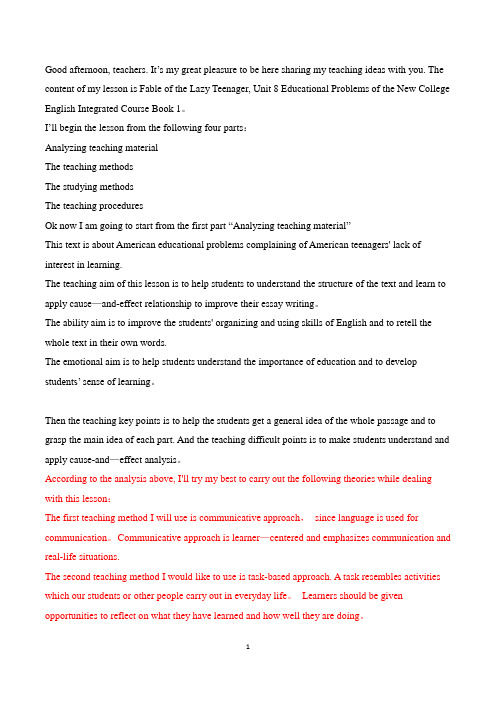
Good afternoon, teachers. It’s my great pleasure to be here sharing my teaching ideas with you. The content of my lesson is Fable of the Lazy Teenager, Unit 8 Educational Problems of the New College English Integrated Course Book 1。
I’ll begin the lesson from the following four parts:Analyzing teaching materialThe teaching methodsThe studying methodsThe teaching proceduresOk now I am going to start from the first part “Analyzing teaching material”This text is about American educational problems complaining of American teenagers' lack of interest in learning.The teaching aim of this lesson is to help students to understand the structure of the text and learn to apply cause—and-effect relationship to improve their essay writing。
The ability aim is to improve the students' organizing and using skills of English and to retell the whole text in their own words.The emotional aim is to help students understand the importance of education and to develop students’ sense of learning。
